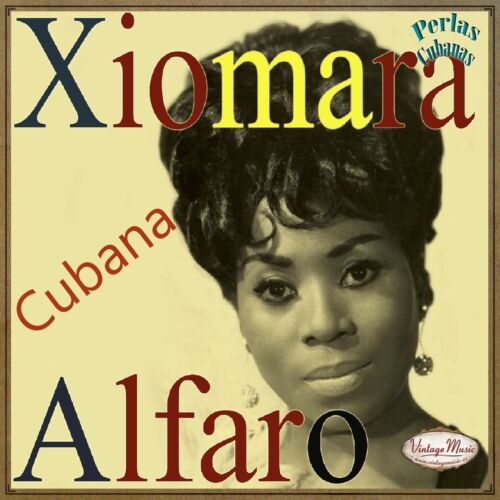Xiomara Alfaro González nació en La Habana, Cuba el 11 de mayo de 1930. Fue una estrella de la escena musical cubana de la década de 1950. Se hizo famosa como cantante de boleros en parte por la forma en que los cantaba con su voz de soprano. Era conocida como “El Ruiseñor de la Cancion” y como “La Alondra de la Cancion”.
Marcó un estilo propio en la canción popular cubana, con su repertorio de boleros en su voz de soprano de coloratura de impresionantes agudos, artista contemporánea de Olga Guillot , Celia Cruz y Omara Portuondo.
Como sucedió con casi la gran mayoría de las cantantes cubanas, Xiomara Alfaro se ganó un concurso en una radio cubana y desde ese momento quedó marcado su destino como cantante.
Interprete de la música romántica, del bolero en especial, que cubrió toda una etapa de la canción popular cubana y latinoamericana, que gozó de una gran y justificada admiración por parte de varias generaciones de hispanoparlantes.
VIDEOS- Xiomara Alfaro canta “Siboney”…
Su experiencia como actriz fue en teatro musical, cabaret, radio y televisión. Una soprano de coloratura, su interpretación de la Siboney del compositor y pianista cubano Ernesto Lecuona fue la favorita del compositor.
CARRERA ARTISTICA…
Se inició en revistas musicales en los años 50 y en espectáculos de cabaret, actuó en Tropicana y realizó números espectáculos en diversos países del mundo, editó más de 28 discos, alguno con la colaboración de Bebo Valdés o Ernesto Duarte Brito, entre otros.
Ella aparece en 28 álbumes grabados para RCA Victor y otros sellos a lo largo de su carrera. Estaba fue casada con el pianista Rafael Benítez. La carrera de Alfaro la llevó del Tropicana de La Habana al Carnegie Hall de Nueva York y al Moulin Rouge de París.
Hizo una gira con la coreógrafa de vanguardia Katherine Dunham, con quien apareció, junto con las estrellas Sylvana Mangano, Vittorio Gassman y Shelly Winters, en la película Mambo de 1954, filmada en Italia. Alfaro también protagonizó Olé…Cuba!, una película de 1957 que también contó con la participación de Celia Cruz.
Xiomara se fue de Cuba a los Estados Unidos en 1960. Su estilo propio y singularidad no se había presentado en la interpretación de la canción popular cubana, orientando su actividad hacia el bolero, para lo que se le escogió un repertorio que se adaptada a su asombrosa voz de soprano, la que le permitía hacer impresionantes registros agudos, lo que fue casi inmediatamente aceptado por los amantes del bolero, ya que se trataba de algo novedoso y con características musicales muy sonoras adornadas con esas notas tan sorprendentes, mas propio de una interprete del bel canto que de una cantante de música popular.
VIDA PERSONAL…
Casada con el pianista panameño Rafael Benítez, quien ha sido su arreglista y director de orquesta artístico colaborando en la grabación de sus discos. No dejo descendencia.
Falleció en Cape Coral, Fla. el 24 de junio de 2018 a la edad de 88 años.
XIOMARA ALFARO, “THE SKYLARK OF THE SONG” LEAVES US WITH HER MEMORIES. PHOTOS
Xiomara Alfaro González was born in Havana, Cuba on May 11, 1930. She was a star in the Cuban music scene of the 1950s. She became famous as a bolero singer in part because of the way she sang boleros in her singing voice. soprano. She was known as ‘El Ruiseñor de la Cancion’ (The Nightingale of Music) and as ‘La Alondra de la Cancion’ (The Lark of Music).
She marked her own style in Cuban popular song, with her repertoire of boleros in her impressive high-pitched coloratura soprano voice, a contemporary artist of Olga Guillot, Celia Cruz, and Omara Portuondo.
As happened with almost the vast majority of Cuban singers, Xiomara Alfaro won a contest on Cuban radio, and from that moment her destiny as a singer was marked.
She interprets romantic music, especially bolero, which covered an entire stage of Cuban and Latin American popular songs, which she enjoyed great and justified admiration from several generations of Spanish speakers.
Her experience as an actress was in musical theater, cabaret, radio, and television. A coloratura soprano, her interpretation of Siboney by Cuban composer and pianist Ernesto Lecuona was the composer’s favorite.
ARTISTIC CAREER…
He started in music magazines in the 50s and in cabaret shows, he performed at the Tropicana and performed in many shows in various countries around the world, he released more than 28 albums, some with the collaboration of Bebo Valdés or Ernesto Duarte Brito, among others.
She appears on 28 albums recorded for RCA Victor and other labels throughout her career. She was married to the pianist Rafael Benítez. Alfaro’s career took her from the Tropicana in Havana to Carnegie Hall in New York and the Moulin Rouge in Paris.
She toured with avant-garde choreographer Katherine Dunham, with whom she appeared, along with stars Sylvana Mangano, Vittorio Gassman, and Shelly Winters, in the 1954 film Mambo, shot in Italy. Alfaro also starred in Olé…Cuba!, a 1957 film that also featured Celia Cruz.
Xiomara left Cuba for the United States in 1960. Her own style and singularity had not been present in the interpretation of the Cuban popular song, directing her activity towards the bolero, for which a repertoire was chosen that was adapted to her amazing soprano voice, which allowed her to make impressive high registers, which was almost immediately accepted by bolero lovers since it was something new and with very sonorous musical characteristics adorned with those surprising notes, more typical of an interpreter of the bel canto than of a singer of popular music.
PERSONAL LIFE…
She is married to the Panamanian pianist Rafael Benítez, who has been her arranger and her artistic conductor, collaborating in the recording of her albums. She left no offspring.
She passed away in Cape Coral, Fla. on June 24, 2018, at the age of 88.
Agencies/ Wiki/ Ecured/ XiomaraAlfaroBio./ Extractos/ Excerpts/ Internet Photos/ YouTube/ Arnoldo Varona/ www.TheCubanHistory.com
THE CUBAN HISTORY, HOLLYWOOD.









